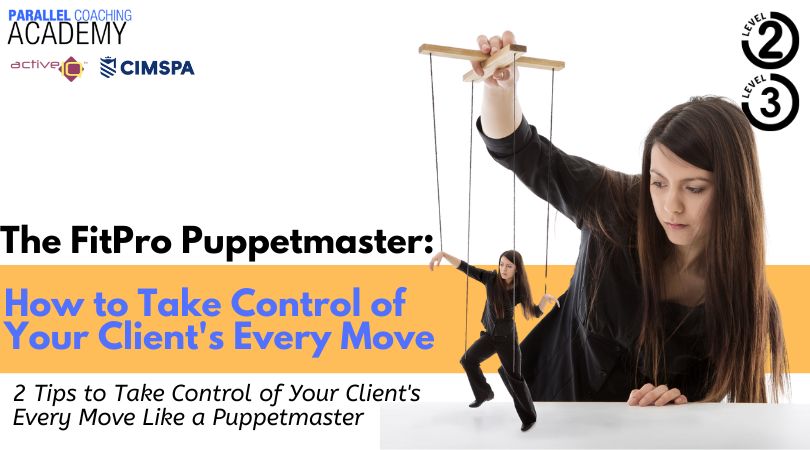Have you ever wished you could take control of your client’s every move?
Kinda like a puppetmaster,
you could do the exercise for them, with the correct technique and to the right intensity
You could even get them to go deeper in the squat or to focus on certain muscles,
and they would oblige, just like a puppet on a string.
Turns out you can’t put a string on your client’s arms and legs and do the movement for them,
neither can you go hands-on and spend the session pushing them around.
But there is something you can do…
One of our FitPro learners, Sarah, reached out to us. She was absolutely distraught because her client’s squat technique wasn’t IMPROVING,
even though as the FitPro she had done EVERYTHING “properly”.
Sarah was in tears, and worried that she had FAILED as a FitPro. She was concerned that her client would either get injured or STOP training altogether.
Blaming herself for not being able to correct the client, or control the client’s every move.
And fearful of adding load to the squat bar, knowing that the client’s technique was far from perfect
She spent ages correcting the client, getting her to STOP and START the movement,
Hips to the left,
Bum down a bit
Head up a bit more
Chin down a centimetre
Shoulder blades back…
But here’s the thing
All of these clunky teaching points were time-consuming and confusing for the client.
There is a better way to improve your client’s technique.
Here are my 2 Tips to Take Control of Your Client’s Every Move Like a Puppetmaster
1.External not Internal
Sarah had been using a list of internal cues with her client, using commands like…
“Shoulders Back, Hips Forward”
These INTERNAL teaching points are difficult for the client to interpret and action
So instead, use External cues
These are using commands that are outside of the body, like:
“Lift the heart to the sky”
“Squeeze the glutes like there’s a £50 note between your butt cheeks”
“Keep the feet on tramlines”
These external cues give a visual representation of WHAT your client needs to change.
As a result, they can action it straight away
Sarah had been using a list of internal cues with her client, using commands like…
“Shoulders Back, Hips Forward”
These Internal teaching points are difficult for the client to interpret and action
So instead use External cues
These are using commands that are outside of the body, like:
- “Lift the heart to the sky”
- “Squeeze the glutes like there’s a £50 note between your butt cheeks”
- “Keep the feet on tramlines”
These external cues give a visual representation of WHAT your client needs to change.
As a result, they can action it straight away
2. See Your Client Through an XRay Machine
Every time your client moves, they leave clues about their body
A squat is a great opportunity to see what is happening with your client
Take time to REALLY look at your client and how they are moving
This information is invaluable,
Instead of telling your client to correct every joint action like Sarah was doing..
You can focus on correcting one joint action, that will correct EVERYTHING else
The best way to do this is to observe your client like you are a human XRay machine
and take note of every shift or compensation
So we have put together a Squat Analysis cheat sheet that will transform how you look at a Squat
Whilst observing the squat you can record the compensations in each joint,
You can then put the relevant stretches and strengthening exercises into their workouts
You may know already know that if the knees adduct towards the midline,
it indicates tight Adductor Muscles and weaker Glutes/ Abductors
Or that a kyphotic posture in the upper back means a tight chest
if you aren’t aware of what these compensations mean, I have something for you
Your invite to the Squat Assessment Bootcamp
Learn A Clear Strategy To Observe & Interpret Client Movement Compensations, aka A Squat Assessment.Fill your knowledge gaps, by learning “what to look for” when observing client posture and technique. Plus, identify client postural compensations, and learn how to correct them.
- ✔️ Observe your client’s movement in detail
- ✔️ Recognise postural compensations in your client
- ✔️ Identify joints that are misaligned
- ✔️ Understand which muscles are tight and weak in the body
- ✔️ Learn how to effectively program to correct compensations

Click the link to find out more and join us:
https://courses.parallelcoaching.co.uk/products/squat-assessment-bootcamp/
Dedicated to More
Hayley “Take Control of Your Client’s Every Move” Bergman
Parallel Coaching
P.S. You can also find us on the following platforms:
Instagram: https://www.instagram.com/parallelcoaching
Facebook: https://www.facebook.com/ParallelCoaching
Twitter: https://twitter.com/ParallelCoach
YouTube: http://bit.ly/2F1Z1bs
Read more Planning blogs: HERE

